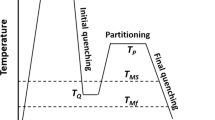Abstract—In this paper, we describe an approach to the neuromodel study of the anisotropy of the mechanical properties of alloyed steels. The strength characteristics of the considered steels is comprehensively studied with reference to the microstructure along the section of the blank. Based on the results of the research, we put forward the thesis that at insufficiently deep cooling during quenching, the preserved austenite will decompose either during subsequent holding during tempering with the formation of pearlite structures with low mechanical properties or during subsequent cooling after tempering with the formation of acicular troostite and martensite with high strength properties, but with low ductility and toughness properties.



Similar content being viewed by others
REFERENCES
Prokhorov, A.P. and Betina, T.A., Model study of the application of the BATR process for hardening the contact surfaces of gear wheels, Uprochnyayushchie Tekhnol. Pokrytiya, 2021, vol. 17, no. 12, pp. 547–554. https://doi.org/10.36652/1813-1336-2021-17-12-547-554
Prokhorov, A.P. and Barinova, N.V., Studying the evolution of microstructure and properties of duplex corrosion-resistant alloy Kh3CrNiMn 22-2-5, Sovrem. Mater., Tekh. Tekhnol., 2021, no. 5, pp. 15–24.
Anoshina, O.V., Trubnikova, A.S., Milder, O.B., Tarasov, D.A., Ganeev, A.A., and Tyagunov, A.G., Modeling of changes in heat resistance of nickel-based alloys using Bayesian artificial neural networks, Pis’ma Mater., 2020, vol. 10, no. 1, pp. 106–111. https://doi.org/10.22226/2410-3535-2020-1-106-111
Prokhorov, A.P., To a method of evaluating the defective structure of the material of high-strength flat sheet product of normal thickness, Vestn. Nauki Obraz. Severo-Zapada Ross., 2021, vol. 7, no. 3, pp. 20–26.
Kamzanov, N.S., Kanazhanov, A.E., and Orazbaeva, A.N., Physical foundations of determining the mechanical properties of metals, Vestn. Kaz. Akad. Transp. Kommun. Tynyshpaeva, 2020, no. 2, pp. 36–43. https://doi.org/10.52167/1609-1817-2020-113-2-36-43
Prokhorov, A.P. and Betina, T.A., Method for estimating the effect of hydrostatic pressure on the elastic characteristics of metals with bcc and fcc lattices, Sovrem. Mater., Tekh. Tekhnol., 2021, no. 1, pp. 48–51. https://doi.org/10.47581/2021/SMTT/34.1.008
Chirkova, A.G., Makhutov, N.A., Kuzeev, I.R., and Gafarova, V.A., Calculation-experimental evaluation of austenic steel mechanical properties variation in operation, Nauchn. Tr. NIPI Neftegaz GNKAR, 2019, no. 4, pp. 67–72. https://doi.org/10.5510/OGP20190400413
Zhang, X. and Wen, Z., Simulation of the temperature, microstructure and mechanical properties of cold-rolled stainless steel SUS430 under continuous annealing, Metalloved. Term. Obrab. Met., 2017, no. 12, pp. 62–70.
Kurban, V.V., Improving the quality of hot-rolled pipe sheet steel in mechanical properties with the use of neural network modeling, Cand. Sci. (Eng.) Dissertation, Magnitogorsk, 2006.
Wang, P., Huang, Z., Zhang, M., and Zhao, X., Mechanical property prediction of strip model based on PSO-BP neural network, J. Iron Steel Res. Int., 2008, vol. 15, no. 3, pp. 87–91. https://doi.org/10.1016/S1006-706X(08)60132-6
Larina, T.V., Kutenkova, E.Yu., Minin, O.V., and Minin, I.V., The influence of anisotropy of properties on the changes in the physical and mechanical properties of the metal surface, Interekspo Geo-Sibir’, 2016, vol. 5, no. 1, pp. 229–233.
Larina, T.V., Kutenkova, E.Yu., Tymkul, V.M., Minin, O.V., and Minin, I.V., Mathematical model analysis of surface condition of structural materials, Interekspo Geo-Sibir’, 2014, vol. 5, no. 2, pp. 98–103.
Chzhan, Dzh., Gao, P., and Fang, F., Modeling of ATPSO-BP network and its application to forecasting mechanical properties, Vychislit. Materialoved., 2019, vol. 163, pp. 262–266.
Mohanty, I., Sarkar, S., Jha, B., Das, S., and Kumar, R., Online mechanical property prediction system for hot rolled IF steel, Ironmaking Steelmaking, 2014, vol. 41, no. 8, pp. 618–627. https://doi.org/10.1179/1743281214Y.0000000178
Chen, M.Y. and Linkens, D.A., A systematic neuro-fuzzy modeling framework with application to material property prediction, IEEE Trans. Syst., Man, Cybern., 2001, vol. 31, no. 5, pp. 781–790. https://doi.org/10.1109/3477.956039
Author information
Authors and Affiliations
Corresponding author
Ethics declarations
The authors declare that they have no conflicts of interest.
Additional information
Translated by A. Ivanov
About this article
Cite this article
Prokhorov, A.P., Zhukova, A.A. Neuromodel Evaluation of Anisotropy of Properties over the Product Cross Section during Hardening Treatment. Steel Transl. 52, 523–529 (2022). https://doi.org/10.3103/S0967091222050072
Received:
Published:
Issue Date:
DOI: https://doi.org/10.3103/S0967091222050072




